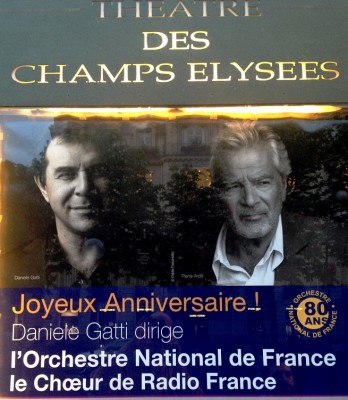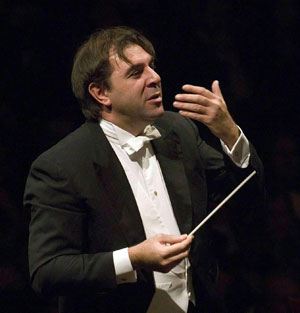80 Years – Orchestra National de France
80 Years Orchestra National de France
Review by Henning Høholt
PARIS/FRANCE: This spring Orchestra National de France celebrates its 80 Years birthday, with three Paris concerts at Theatre des Champs Elysees.
As the no one orchestre in France, every week either in radio or tv on France Musique, the orchestra has a large responsibility to perform a very wide choise of classical and comtemporary compositions by all the worlds leading composers, but also to take well care of what is new in the symphonic way, of course by the many great and interesting French contemporary composers, but also having an eye on what is importent ariound in the world
using an elastic band placed at the base of the penis. Thedegraded by the enzyme phosphodiesterase type V (PDE V). What is sildenafil?.
.
In this way the program comitee and the music chief of the orchestrea Daniele Gatti is doing a great job. The orchestras repertoire performed is of the highest possibel class, and allways with a lot of excellent international and national soliists. Furthermore gives its cooperation with the Choeur de Radio France axtra many good possibilities.
Since Daniele Gatti took over as musicchief after Kurt Masur, he is continuing the good line for the orchestra, and it is allways a pleasure to enjoy their concerts, which for me gives a lot of great variations, and also possibility to listen to unexpected combinations of works, expressions and composers during one concert evening.
This last of the 80 Years Jubilee concerts was opened by Ludwig van Beethovens wonderful Prometeus Ouverture opus 43. An excellent work to give the whole evening a great Jubilee temperature.
This was followed by, what i feeled like the highlight in this performance, Henri Dutilleux beautiful and demanding (both for the orchestra and the audience, Métaboles for orchestra. Dutilleux, who died in 2013, is a demanding composer, a his musical language is difficult, and absolutely not normal, (but what is normal today in the musical world?). He manage to form an atmosphaere with his different parts in the work, who are as following: Incantatoire, Linéaire, Obsessionnel, Torpide, Flamboyant
.
Métaboles was commissioned by the Cleveland Orchestra under George Szell, After Henri Dutilleux completed this work, which he looked up all the words beginning with the prefix “meta-“ in the dictionary to find a title for it. He eventually settled on Métaboles because, in physiology, the word refers to the continuous, incremental chemical transformation of one compound into another. In the Dutilleux´s piece, the word describes the structure of the work, as each of the five brief orchestral movements is a transformation of the movement that succeeds it, and the final movement combines all that has come before
.
The first movement, “Incantatoire,” , opens with sustained E naturals in the winds, punctuated by sharp chords from the orchestra. The E becomes natural a pivotal point for the entire work. The remainder of the movement opposes freer melodies on the clarinet, flute, and trumpet to the E naturals. In “Incantatoire,” the strings only have the melody for a brief period and that brief melody becomes the basis for the second movement, “Lineaire,” written solely for the strings. Throughout the movement, there is only one prominent melodic line at a time, which gives it a “linear” feel. The music itself is slow and nocturnal, with Dutilleux’s marvelous ear for timbres providing some gorgeous sounds.
The skittish third movement “Obsessionnel,” takes an idea from “Lineaire,” makes it faster and more rhythmic, and entrusts it mainly to the brass, although pizzicato strings play a large role, as well. “Torpide,” the fourth movement, features percussion accents on a series of sustained chords in the winds and brass, which are slowed-down remnants of the third movement. The composer‘s use of percussion is highly inventive in using motion to suggest a lack of motion.
“Flamboyant,” is the last movement, is marked and brings all the instruments together. After all the instruments have entered playing characteristic music from the first four movements, the winds play the E natural chords from the first movement. The whole orchestra then rushes headlong into a rousing coda. Dutilleux’s highly individual orchestration always pleases the ear, and the formal methods he uses in Métaboles unify the work. For me it was the highlight of the evening
.
After the break followed Igor Stravinsky´s concertversion of Oedipus Rex to the text of Jean Cocteau, created 30th May 1927 at Théâtre Sarah Bernhardt in Paris, and in scenic version at the Vienna Opera teh 27th February 1928. In this version here in Paris with Pierre Arditi splendid reciting the text. Oedipus Rex is too a demanding work, it needs excellent vocally soloists, who can underline the charachteres. The tenor Nikolai Andrei Schukoff had the demanding and ungrateful job to sing the King Oedipus role
. He di it well, a lot of it is very high, unfortunately, i would have prefered a tenor with an even more beautiful voice, but since it also need to be characteristic to the figure he shall perform it is an ungrateful role. I more enjoyed the other tenor in the cast Benjamin Bernheim as the Shepherd (Le Berger), he has a very beautiful voice, and it was a pleasure to listen to. Sonia Ganassi, (mezzo soprano) was Jocaste. The most impressive of the voices was Georg Zeppenfeld as Tiresias, a great voice with an extraordinary sound. We also had the pleasure of John Relyea, bass as Créon and the Messenger.
The large male quire did an excellent job. The orchestre sounded brilliant, with Sarah Nemtanu as concertmaster playing the beautiful violin solo parts.


